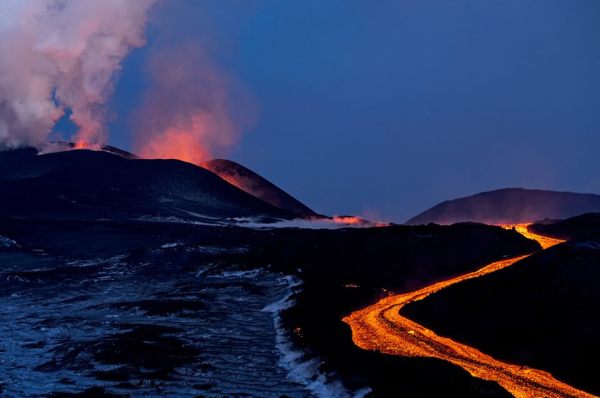http://www.volcanodiscovery.com/view_news/24796/Volcanic-activity-worldwide-12-13-January-2013-Stromboli-Lokon-Empung-Kizimen-Manam-Tolbachik.html
Stromboli (Eolian Islands, Italy): During a larger explosion of the NE crater, part of the northern crater wall collapsed. The explosion and resulting rockfall caused a large ash and steam plume that drifted over the island and scared many of the inhabitants.
When we visited the Sciara del Fuoco in the afternoon, a small lava flow was actively issuing from the effusive vent (that had been active intermittently during the previous days) located just beneath the new crater breach. The flow was about 10 meters wide and had previously reached about 150 m length where a cooling flow front was still visible. During the afternoon / evening, the flow continued to be quite active, producing many incandescent avalanches of blocks tumbling down the Sciara.
Lokon-Empung (North Sulawesi, Indonesia): Further ash explosions occurred today and yesterday. VSI maintains status 3 (out of 4) of the volcano and recommends not to approach the Tompaluan crater within a radius of 2.5 km.
Kizimen (Kamchatka): An ash plume was observed at 15,000 ft (4.6 km) altitude 12 Jan morning, possibly from a pyroclastic flow or an explosion at the growing lava dome. A new lava flow extrudes from the summit on the north-eastern flank of the volcano. Incandescence of the volcano summit, hot avalanches on the western and eastern volcanic flanks and strong gas-steam activity accompany this process.
Tolbachik (Kamchatka): The eruption continues with little changes. KVERT reports constant high tremor and effusion of lava flows from the southern fissure.
Manam (Papua New Guinea): An large explosion occurred yesterday morning. VAAC Darwin reported an ash plume rising to 45,000 ft (approx. 14 km) altitude.
Other volcanoes: No significant changes have occurred at most volcanoes we monitor.
Earthquake-report.com summarizes the activity of volcanoes in Central and Southern America as follows (12 Jan):
Exhalations continue to occur at a reduced rate (less than once per hour on average) at Popocatepetl volcano (Mexico). Small volcanic earthquakes continue at Colima volcano, suggesting further surface activity should be expected there.
Seismicity is reduced at Fuego volcano (Guatemala) and Santa Maria volcano. Both seismicity and a volcanocam photo indicate a recent exhalation from the Satiaguito Dome Complex (Santa Maria volcano). Nearby Pacaya volcan chatters with frequent volcanic earthquakes.
Banded volcanic tremor at San Cristobal volcano (Nicaragua) has become more pulsatory and diminished during the past 24 hours. Elevated volcanic tremor continues at Masaya volcano and volcanic earthquakes (and a train of volcanic tremor) continue to affect Concepcion volcano today.
Volcanic tremor has diminished at San Miguel volcano, but occasional volcanic earthquakes have struck the volcano the past few days.
Numerous small earthquakes rattle Colombian volcanoes: Nevado Del Ruiz, Machin, and Galeras today.
Tungurahua volcano (Ecuador) has returned to slumber, internal activity appears on the increase again at Reventador volcano, and a few small earthquakes have affected Cotopaxi volcano during the past few days.
SERNAGEOMIN reports that seismicity has diminished slightly beneath Copahue volcano during the past 24 hours. Just over 1000 events occurred during that period.



























